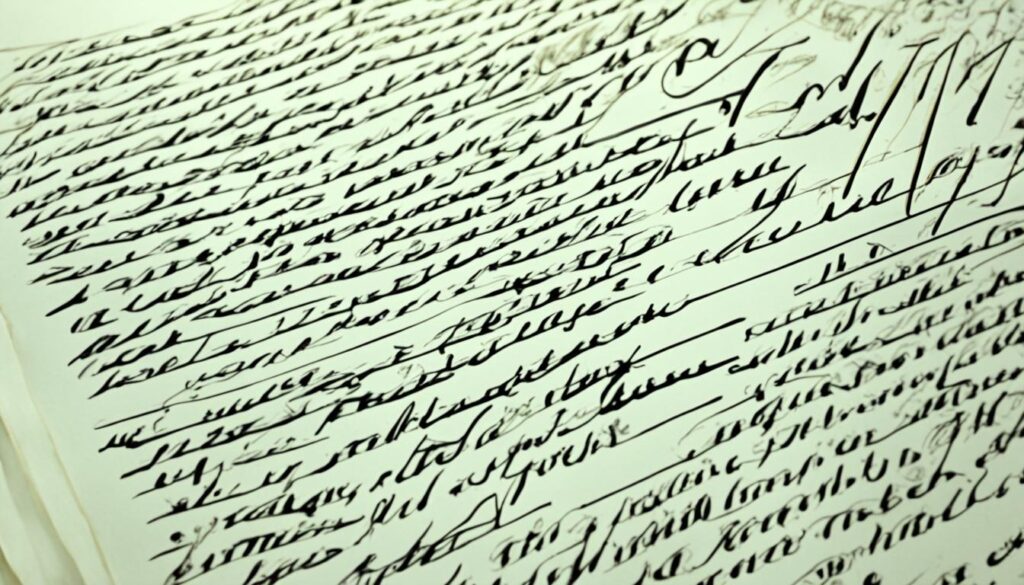The Renaissance era was full of geniuses, but Leonardo da Vinci was a true polymath. He excelled in art, science, and engineering. His use of mirror writing was one of his most fascinating habits. This backwards writing technique has captured the interest of scholars for centuries.
Da Vinci’s mirror writing was a special kind of cryptography. He wrote from right to left, so the text looked like gibberish unless reflected in a mirror. This method was mostly seen in his personal notebooks. For his public works, he used the standard left-to-right writing.
The reasons why he chose this unique writing style are still a mystery. Some think it was to keep his ideas private. Others believe it might have been easier for a left-handed person like him. Either way, it makes Da Vinci’s legacy even more intriguing.
Key Takeaways
- Leonardo da Vinci used mirror writing in his personal notebooks
- His backwards writing could only be read when reflected in a mirror
- This practice is considered a form of early cryptography
- Da Vinci used normal writing for public works
- The exact reasons for his mirror writing remain unknown
- This unique habit adds to the intrigue of Da Vinci’s genius
The Enigma of Da Vinci’s Mirror Writing

Leonardo da Vinci’s mirror writing is a mystery that still captures our imagination. He wrote in reverse, making his texts only readable in a mirror. This skill was so sharp that he could write backwards as easily as forwards.
Da Vinci was not the only one to use mirror writing, but he used it a lot in his notebooks. This has made his work very interesting to scholars and fans of the Da Vinci code. Some think he used it to keep his ideas safe. Others see it as a natural talent of his.
Later works also show mirror writing, like Matteo Zaccolini’s 17th-century book on color and Ottoman Empire calligraphy from the 18th and 19th centuries. But Da Vinci’s use of mirror writing stands out. It continues to amaze people who are drawn to his creative genius and innovative ways in art and science.
Theories Behind Leonardo’s Unique Writing Style
Leonardo da Vinci’s mirror writing still puzzles scholars today. One idea is that it helped him, being left-handed, avoid smudging his ink. This way, he could work efficiently without spoiling his art.
Some think he used it to keep his ideas safe. Writing backwards could hide his work from others who might want to steal it. This fits with his secretive nature and the political times he lived in.
Another theory is that it was a challenge for his mind. Da Vinci loved to push the limits of language and communication. This shows his innovative spirit and his drive to learn more.
Some believe it was a way to train his brain. Writing backwards might have improved his spatial thinking and how he processed information. This ties into his fascination with ambigrams and other puzzles that need special thinking.
Even with many theories, we still don’t know for sure why Da Vinci wrote in the mirror. This mystery makes his genius even more intriguing. It keeps scholars and art lovers deeply interested.
Legacy and Impact of Da Vinci’s Mirror Writing
Leonardo da Vinci’s mirror writing changed art, science, and culture. It made people curious about how our brains work and how we write. It also led to new ways of making art, like ambigrams and secret messages.
Da Vinci’s mirror writing also helped in real life. For example, the word “AMBULANCE” is written backwards on emergency vehicles. This makes it easy to read in the rearview mirror. It shows how Da Vinci’s ideas are still useful today.
Today, Da Vinci’s mirror writing still fascinates experts and the public. It’s a big part of popular culture, seen in books like the Da Vinci Code. This shows how Da Vinci’s unique writing and codes still challenge us today.
Da Vinci’s mirror writing proves his genius. It shows us that thinking differently can lead to new ideas. By studying his work, we learn more about his creative mind. This connects the art of the Renaissance to modern cryptography.

Leave a Reply